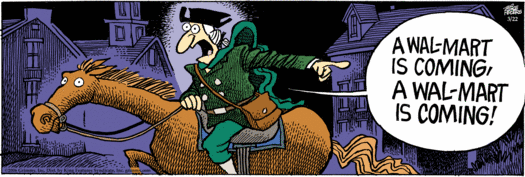Walmart in DC?

Mother Goose & Grimm comic strip, 3/22/2006
The new issue of the Washington Business Journal reports, in "Wal-Mart on the prowl for a D.C. site," that Walmart is looking at a Southeast DC location, on land owned by Urban City Interests, abutting Poplar Point, but that they need more land than the developer has, and they want some of the Poplar Point land, cheap, because according to Urban City Interests principal Jeff Epperson, "the chain does not expect to pay top dollar for the land because of the foot traffic and tax revenue that its stores bring to an area."
The reality is more complicated.
1. The proposed store would be 80,000 to 100,000 square feet. A typical Walmart store does about $425/s.f. in annual sales, although urban stores are likely to have higher sales of $550/s.f. Walmart stores that sell groceries typically do 49% of their business in groceries. In DC, such sales are not taxed.
So a 100,000 s.f. Walmart store not selling groceries at revenue of $425/s.f. would gross $42,500,000, and would generate $2,550,000 in sales taxes. But if half the sales come from groceries, that cuts the sales tax revenues in half, to $1,225,000 annually. At $550/s.f. in sales, the tax revenue would be higher at $3,300,000, and half that, $1,650,000 if groceries are sold.
The reality is then that a Walmart store will generate more sales tax revenue, but not astronomically. Plus it has to be determined how much of those tax revenues would be cannibalized from other DC stores, and how much from Maryland and Virginia, for the net contribution.
In any case, the economic impact of a Walmart store in DC is not so significant that it is worthy of significant public benefits.
2. Regardless of what Mr. Epperson says, Walmart stores are not designed to provide customers to nearby businesses, what he refers to as "foot traffic." See this past blog entry, "Jumping in bed with the devil--it's hot, but will you survive the heat?."
The Walmart business model is designed to capture 100% of consumer spending from its customers--it doesn't get it all, but not for want of trying--and therefore can't be considered an anchor store in the way that supermarkets and department stores anchor shopping centers--spending a lot of money on advertising, drawing customers, who also then shop in adjacent stores. (This is why typically supermarkets and department stores ask for incentive payments, because they spend a lot of money on advertising which benefits other businesses, not only their own business.)
3. Walmart stores generally do not increase business for other stores, they put other stores out of business.
4. Plus, typically, chain stores like Walmart spend very little money on services and goods purchased locally. This is why "buy local" campaigns stress the point that spending in locally owned stores has a multiplier effect of about 45 cents (for each dollar spent in the store, an additional 45 cents is generated in additional economic activity), while for each dollar spent in a chain store, only 15 cents in additional economic activity is generated (usually as a result of payroll).
5. I suppose that some people can say that hipsters and pro-urban people prefer Target over Walmart, even though they are both discount stores (see "Columbia Heights Hipsters Stumble Into Target Territory" from the Post) just like hipsters and chic types like Whole Foods Supermarket even though it is a chain.
I do think that attracting chains and big boxes to urban locations is worth doing. The DC/USA center (Target, Bed Bath and Beyond, Best Buy, Staples, Payless Shoes, Marshalls, etc.) does recapture sales that went out of the city. And if properly leveraged, and customers at the center can be convinced to patronize nearby businesses and business districts as part of a more complete shopping experience, then the city, merchants, and residents will get a huge payback.
But Walmart stores aren't conducive to this kind of approach. As the resources listed below point out, when Walmart comes to town, other stores close, and it is rare for new stores to open.
-- Summary of the Local Costs and Benefits of a Wal-Mart Store (from a presentation at the American Planning Association Ohio Chapter state conference)
-- "When Wal-Mart comes to town: study examines impact on local market" from DSN Retailing Today
-- "Analyzing the impact of Wal-Mart Supercenters on local food store sales" by Artz, Georgeanne M., Stone, Kenneth E., American Journal of Agricultural Economics
-- Table, retail sales tax revenues generated by different types of stores, prepared by the HDL Companies.
--------------
As I have mentioned from time to time, most communities have an "economic development" element in their Comprehensive Plans, but it's not too normative--anything goes, anything qualifies as quality economic development.
But the fact is "building a local economy" is fundamentally different from mere "economic development." Upwards of 75% of the monies earned in a particular store of a big box national (or internationally-owned) chain leaves the community, while that is reversed for locally-owned businesses.
Labels: commercial district revitalization, economic development, formula retail, property development, tax incentives



0 Comments:
Post a Comment
<< Home